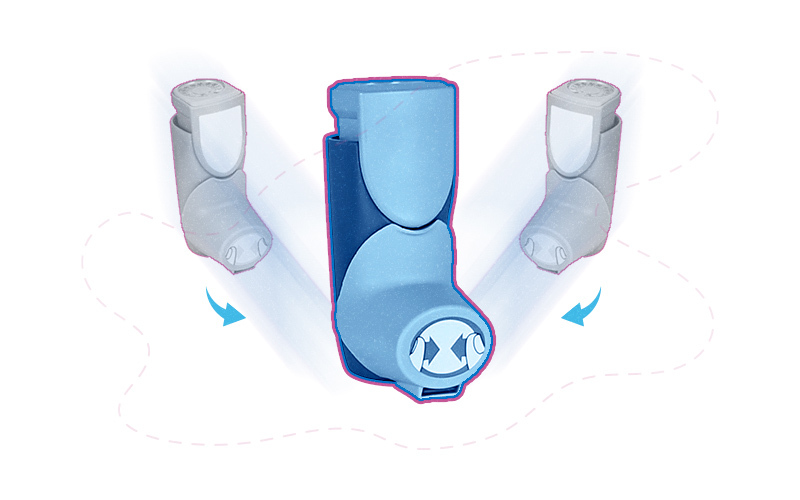SMART: A new approach to asthma management

Until recently, the typical approach to asthma involved two inhalers. In its first update since 2007, the National Asthma Education and Prevention Program now recommends the use of Single Maintenance and Reliever Therapy (SMART) for selected patients.
Rather than an inhaled corticosteroid for daily maintenance and an inhaled bronchodilator for exacerbations, SMART uses the same inhaler for both prevention and rescue therapy. This strategy, delivering a corticosteroid and long-acting beta agonist together, allows for a lower regular steroid dose, with additional doses as patients use the inhaler to relieve asthma symptoms.
We checked in with pulmonary specialist Jonathan Gaffin, MD, at Boston Children’s Hospital to unpack what switching to SMART means for practice.
Why the change?
A critical mass of data indicate that combining maintenance and rescue therapies offers better asthma control, reducing the number of exacerbations. Patients have used SMART successfully in Europe for seven years, although it is still considered off-label in the U.S.

The SMART approach augments anti-inflammatory coverage during times of increased symptoms, when airways may be more inflamed. Each time patients use their inhaler to manage increased symptoms, they also receive some steroid medication for long-term asthma control. This especially benefits patients who tend to skip their daily inhaler if they are feeling well and instead rely on their rescue inhaler. At the same time, SMART enables patients to receive lower doses of daily inhaled steroids, reducing the risk of side effects.
Using a single inhaler for both maintenance and rescue can also improve adherence. And it eliminates medication confusion for patients who tend to mix up their two inhalers.
Which patients should — and shouldn’t — we consider for the SMART approach?
The best candidates for SMART are patients age 5 and older with moderate (step 3 or 4) persistent asthma that is not well controlled despite low doses of steroids. If your patient’s current therapy is controlling their asthma well and they are not having side effects, there is no need to make a change.
SMART may not be appropriate for patients who tend to use their rescue inhaler too often. These patients may take puffs of their rescue medication if they are anxious or perceive being short of breath, even if not due to asthma. If these patients were switched to SMART therapy, this pattern could result in them getting too much inhaled steroid.
How is SMART dispensed?
There are two main formulations, using budesonide or mometasone as the preventive component and formoterol as the rescue component. To ensure that patients have an adequate supply, you may need to prescribe two SMART inhalers at a time.
Only formoterol-containing formulations should be used. Formoterol has a rapid onset bronchodilator effect, similar to albuterol. For budesonide/formoterol, the most commonly used formulation, a maximum of eight puffs are recommended for children age 5 to 11 and 12 puffs for children 12 and older.
Diagnostic testing for asthma
The pulmonary function testing laboratory at Boston Children’s offers several tests to diagnose and monitor asthma. These include spirometry, exercise testing, and Fractional Exhaled Nitric Oxide (FeNO).
Spirometry remains the gold standard for diagnosing airway obstruction and responsiveness of asthma to medications triggers such as exercise. It is the key measure for tracking lung function growth into adulthood, an important predictor of chronic obstructive pulmonary disease.
FeNO, a newer test, provides a measure of airway inflammation that is sensitive to eosinophilic airways disease. It can be helpful in diagnosing asthma and monitoring the response to inhaled steroids; FeNO levels should decrease with regular steroid use. Children breathe out slowly into a small device that measures nitric oxide in the lungs; high levels indicate greater inflammation.
Refer a patient for a pulmonary function test (PDF will download)
How do we explain SMART asthma therapy to patients and families?
Most patients and their parents appreciate the streamlined approach and having just one prescription to track and refill. The key messages we suggest for patients are:
- SMART is a new way of approaching your asthma care that gives you more medicine when you need it most.
- You will use just one inhaler for everyday asthma prevention and for acute symptoms.
- You no longer need to remember which inhaler is which.
- This change will enable you to get enough of the preventive medication to control your asthma long-term.
You and the family should ensure that school and camp nurses have an updated asthma action plan documenting that the child is using a single maintenance and reliever inhaler.
Learn more about pulmonary function tests offered at Boston Children’s or refer a patient for testing.
Related Posts :
-

Mapping cells to create targeted treatments for interstitial lung disease
John Kennedy, MD, MSc, remembers the relative simplicity of his first genetic mapping project. In a Harvard Medical School&...
-

EarlyBird: Addressing dyslexia through game play
Up to 10 percent of the population has dyslexia, yet many children are diagnosed only after struggling with reading for years. ...
-

Will early intervention prevent asthma in school-age children?
Asthma affects about 1 in 10 children, often sending them to the emergency room or causing them to miss school. Allergic conditions ...
-

Four ways to support your teen’s mental health
Being a teen is hard enough, but with the current adolescent mental health crisis, parents should know about the psychosocial ...





